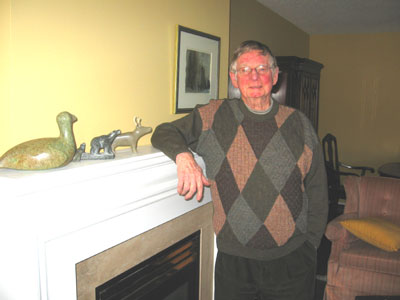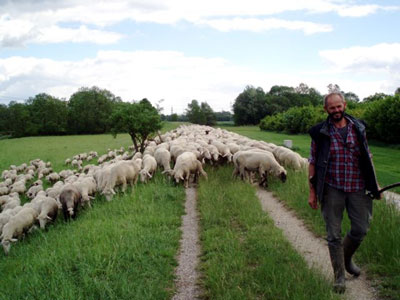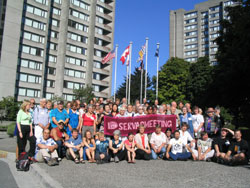A little while ago I mentioned that I stumbled across Verge Magazine by accident and that I planned to interview its editor, Jeff Minthorn.
1. Tell us a little bit about your educational background.
At university, I began studying geography in the Environmental Studies faculty but after my second year, I felt like I was covering the same material over and over again. I transferred into Urban Planning and completed the required courses for the first two years, all in one year, but just before I was about to finish my second term that year, I came to the conclusion that I really wasn’t all that interested in what I was doing.
I decided to take a year off to think about what I did want to do. During that year I worked a lot, did some travelling, and applied for architecture school. Architecture programs are extremely demanding, but it’s also a very broadly based education. I was able to learn a bit about everything from art history to engineering. I think that’s the main reason I actually stuck it out for five years to finish the degree. Although it was demanding, it was also very engaging.
2. You have also done quite a bit of traveling. During university you took a year off to live in Rome. How was that? What were your major learning experiences?
I’ve done a bit of travelling, I guess – more than some people and a lot less than others. I was fortunate that part of my architecture degree involved studying in Rome. Definitely one of the most important lessons that I learned while I was there was about balance and priorities.
I tended to be very single minded – maybe even obsessive for the first few years in architecture school. While I was in Rome, I came to the realization that it wasn’t going to be the hours and hours that I spent holed up in the studio with the rest of my classmates that I would remember. What I would remember would be the afternoons that I spent exploring and painting and drawing the architecture that I was there to study. I made a point of getting into the studio very early in the morning – before anyone else was there – so that I could really be productive. Then I would pack up my sketch books and watercolours in the early afternoon – just when the studio was getting good and noisy – and go out exploring.
3. What other types of traveling have you done?
Part of the year that I was away from university, I spent travelling through Europe. It was the usual student-backpacking-through-Europe experience, but you know, as easy as travelling there is, it really opened my eyes and was a real confidence builder for me. Prior to that, I had never left North America.
A couple of years later, I found work in London, England and lived there for 8 months. That was a bit of an adventure. I had very little money, a working holiday-maker visa, some resumés and sample portfolios, and no job lined up. I spent nearly three weeks and most of my money looking for work. Just when things were starting to look pretty desperate, I found a job in an architect’s office. I managed to save enough money while I was there to buy an old motorcycle and when my contract was up, I traveled from London to Rome and back on it.
4. I was surprised to hear you worked in Antarctica. What did you do there?
Some years ago, I was working here as a wilderness guide and outdoor education instructor (that’s another story!). One of my qualifications was as a Wilderness Emergency Medical Technician (W-EMT). A colleague received a call one day asking if he knew anyone with those qualifications, who would be willing to leave for Buenos Aires in three weeks, and then to Antarctica for four months. He handed the phone to me. Three weeks later, I was helping load provisions onto a ship in Buenos Aires.
I worked as the ship’s EMT, and as a Zodiak driver. I was always the busiest while crossing the Drake Passage – it’s one of the roughest stretches of ocean in the world. Most people were seasick and there were always minor injuries from people being tossed around during heavy seas. I was also the liaison between the ship’s doctor and the passengers. The ship was Russian, as were all of the crew. The doctor, of course, spoke fluent Russian, but no English. We had some very interesting sessions of charades.
5. You have worked in a variety of fields before you started your magazine. Please tell us about your other work experiences and how they helped you in your present endeavour.
Immediately after graduating from university, I worked in architecture for a couple of years before establishing a small building renovation company. I think the main thing that I was able to take from those experiences was how to coordinate the efforts of a team of people to accomplish a task. The design experience has also served me well. Good design is, in a lot of ways, all about conveying ideas in a clear manner.
I also worked as a wilderness guide and instructor for some years. I think that the most important thing that I took from that experience was the importance of trusting the individual strengths and abilities of your team. You may be able to play a lot of instruments yourself, but you still can’t perform a symphony alone.
6. How did the idea of Verge Magazine come into being? What is the magazine about?
Verge Magazine evolved out of a discussion about why so few young people know about the many opportunities that exist to explore things that are a bit off the beaten track. It seemed to us that too many young people simply step onto the conveyor-belt of convention and end up twenty years down the road in jobs they despise, feeling completely unfulfilled. Verge began as an attempt to give young people a glimpse of other options and to encourage them to take some time to explore them before rushing headlong onto that conveyor-belt. I suppose it’s really about opening people’s eyes to opportunities that they may not have been aware of.






